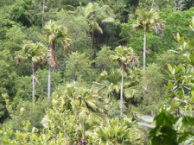Seychelles Flora
|
The majority of books, pamphlets, papers and project proposals highlight and underscore the fact that Seychelles' flora is unique in the world. It survives as a relic of the ancient flora that existed on the Gondwana supercontinent. Millions of years of isolation created ideal conditions for diversification and speciation of the original flora.
The granitic islands of Seychelles support approximately 200 indigenous flowering plant species. Of these, around 70 are endemic species, and there are several endemic subspecies and varieties. There is one endemic family of flowering plants, the Medusagynaceae, 6 monospecific endemic palm genera, including the iconic Coco de Mer, and 5 other endemic genera, only one of which contains more than one species. In addition, there are c. 90 ferns and fern relatives in the granitic islands, c. 110 mosses, c. 110 liverworts and more than 200 lichens. By comparison, there are probably more than 1,100 introduced species! Many were introduced to provide food, timber, medicines and for other useful purposes. Some of the introduced trees now form a vital cover for the steep slopes of the granitic islands; but native species are increasingly threatened by the spread of introduced invasive species, by the activities of the human population of the islands and also by climate change. However, it should be noted that Seychelles has given protected status to around 50% of its total land area and there has been success in propagating many of the endemic flowering plant species in ex situ conservation. The main types of vegetation habitats in the Seychelles granitic islands are cloud or mist forest on the mountain tops, higher altitude forest and mid-altitude forest (often subdivided into several sub-categories such as riverine forest, palm forest), glacis vegetation (on inselbergs), plateau (lowland) forests, coastal fringe, mangrove and freshwater wetlands. |




